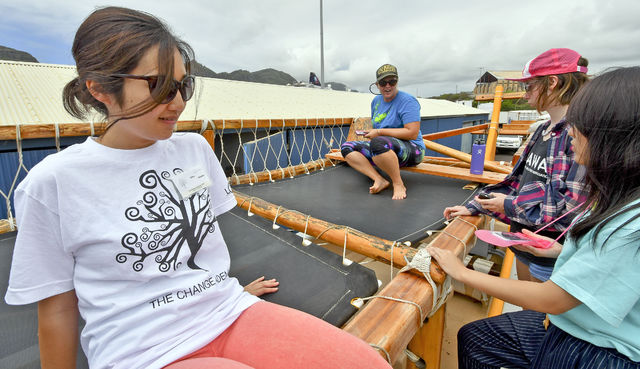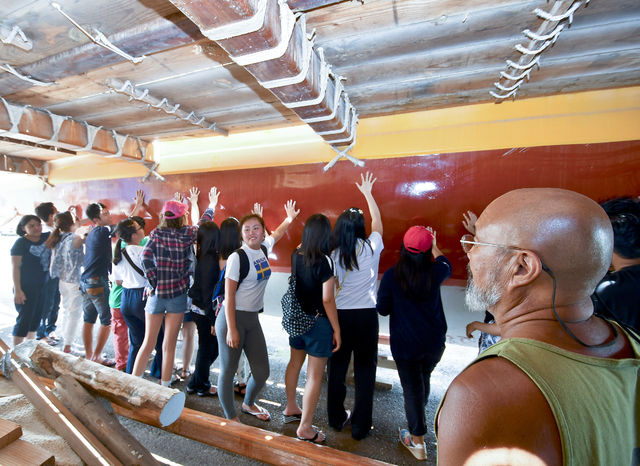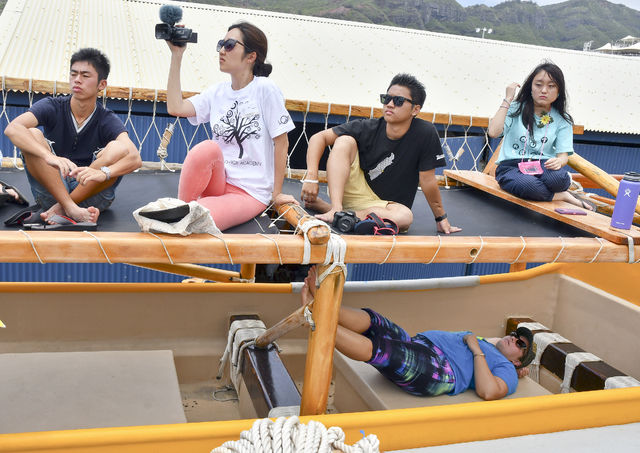NAWILIWILI — We are all here because of previous events, said Dennis Chun of the Namahoe building committee and a Hawaiian Studies instructor at the Kauai Community College. What are we going to do next? Chun was addressing students from
NAWILIWILI — We are all here because of previous events, said Dennis Chun of the Namahoe building committee and a Hawaiian Studies instructor at the Kauai Community College. What are we going to do next?
Chun was addressing students from The Change Academy — a collection of 18 high school students, 11 from Japan, and seven from high schools on Oahu — Thursday at the sailing canoe which is the Kauai version of the Hokule‘a.
The students arrived Wednesday evening on a trip coordinated by Kauai Community College and Kapiolani Community College with Yoshi Tsurumi, a founder of The Change Academy, for the purpose of allowing the students to learn leadership skills toward the end of becoming change agents.
“This is the first time we’re doing a two-week summer camp with the students,” Tsurumi said. “The objective of the camp is to have the students develop into change agents for good — not just for their hometowns, but for all of Japan.”
The students are all from rural areas of Japan, and are joined from students from Oahu high schools.
“There are no students from the big urban centers because the reality is students in the urban centers have lots of opportunities for change,” Tsurumi said. “These students, we have one from Hokkaido who is a descendent of Ainu, a native people, five from Tohoku which was hit by the earthquake and tsunami, and several from island towns outside of Tokyo.”
He said the students from the Tohoku area have been to Hawaii, their first trip being for rest and recuperation from the disaster, to be able to escape the stress of recovery and breathe fresh air and enjoy the sunshine.
“They all have stories,” Tsurumi said. “The students from Tohoku all lost their mothers in the disaster. They lost their homes, they all lost friends, and most of them are still living in relocation houses. How do we rebuild the community they love? They are change agents.”
Ke‘au, Chun’s son, said he was in intermediate school when work on Namahoe began — not construction, but talk with no plans, just discussions. He was on hand to help the students with the tour of the sailing canoe.
Work started on the sailing canoe in 1997 with no molds, no production models, no blueprints, Chun said. Ke‘au watched and helped with the process through his high school career, and beyond.
“It has taken more than 20 years,” said the professor who also sailed aboard Hokule‘a. “We got help from marine architects, and lots of people whose mana‘o is vested in the ship through their signatures and handprints molded into the hulls and other parts of the ship.”
Chun invited the students to add their mana‘o to the countless others by touching the hull and adding their messages to the undersides of the decking and catwalk.
“The No. 1 rule for canoes — whether on land, or in the water,” Chun said. “Don’t fall off the canoe.”




